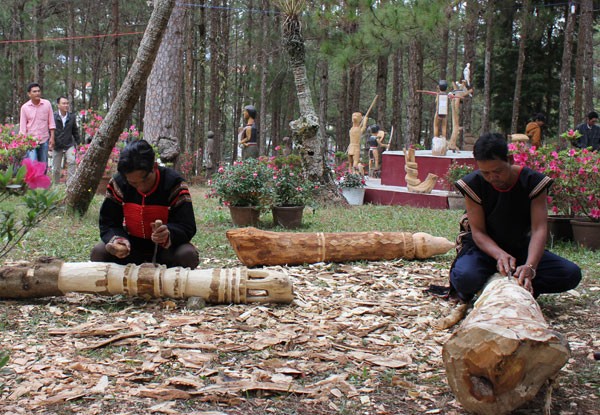(VOVworld) – Grave statues are typical cultural feature of ethnic groups in the Central Highlands. Grave statues of the Bana are not just folk artifacts but contain a philosophy of life.
The Bana believe people were born in the forest and will return to the forest when they die. They believe that death is not the end. After this life, there is the life of dead spirits. From that believe, they have created a unique ritual to see the dead off to the world of spirits. During the ritual, people don’t cry. They play gongs, dance, sing, and party joyfully as they say goodbye to the dead. The living place wood statues around the grave as gifts to show their feelings for the departed love ones.
Painter Dinh Tien Hai, a researcher of Central Highlands culture, told us: “The Bana think that death is not the end but just a change from moving to still life. In the past, the Bana shared all their assets with the dead by making a hole or deforming the utensil. The farewell ritual is the last chance to see off the dead, so the living wholeheartedly make statues for the grave. The statues represent the living accompanying the dead to the infinite world of the spirits. The statues stay there forever.”
The relatives of the deceased cut trees in the forest to make statues. They carve the statues without any blueprint or exact measurement. The statues show their feelings and thoughts about the deceased and their view of life. The grave statues are unique and lively.
The grave statues represent birds, beasts, household utensils, and groups of people standing, sitting, or hugging each other. The most popular statues are people sitting with their elbows on their knees, their arms holding their faces, and sad-looking eyes. People say the statues represent the relatives, sitting beside the grave to talk with the dead person. There are joyful statues of people beating drums and gongs, pounding rice, men and women having sex, and pregnant women. The grave statues illustrate their belief that death is just a start in the spiritual world. Painter Dinh Tien Hai again: “It’s difficult to carve those lively grave statues because they are imprinted with the spirit of the makers. The makers show their love for the dead person and the statues are lively.”
 |
| Artisans carve grave statues |
The grave statues partially reflect the culture and customs of ethnic groups in the Central Highlands. They also refer to the dead person, his or her appearance, character, and career and the feelings of the relatives. Luong Thanh Son, Director of the Dak Lak Ethnic Museum, said: “Ethnic groups in the northern and southern Central Highlands respect the making of grave statues. They carefully make the nicest things for the dead. People in the north Central Highlands carve human statues, while in the south they make statues of animals.”
Grave statues show the creativity, artistic mind, and view of life of the Bana people. They preserve the cultural, architectural, and sculptural values of the Bana.